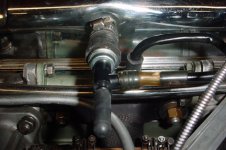Offline
After trying several solutions to the crankcsse oil seepage/leakage problem I finally found one that actually works very well.
The Sixes do not have quite the same problem as the Fours. In the sixes a PCV valve can be inserted between the rocker arm breather to crankcase junction & the oil filter base. This provides a slght vacuum on the crank case under light to moderate throttle openings.
The Fours have a restricted valve cover outlet opening going to the air filter base joint in which a PCV valve could be inserted to provide a slight vacuum on the crank case under light to moderate throttle loadings. The filler cap is normally sealed, with the road draft tube providing necessary ventilation air. Much better than nothing.
A real solution. The carb to carb balance tube is drilled & tapped to accept a 5/15 fitting. This becomes the new source for the PCV valve inlet.
A tube is routed from this new manifold tap, through the added PVC valve, to the original valve cover breather outlet fitting. The original road draft tube is capped.
The PCV calibration allows a moderate vacuum to be pulled on the crankcase. The PCV calibration allows more flow as the throttle is opened. At worst case, full throttle, the valve prevents any build up of crankcase pressure, but never allows a positive presure in the crankcase.
Under actual tests, I show 5 inches of vacuum on the crankcase at idle to light throttle, 7 inches of vacuum at moderate to high throttle, & zero vacuum but no presure at full throttle.
Only a couple of flats on the carb main jet calibration were needed to bring things back into balance.
No more oil leaks from the engine. When the engine is shut off you can hear several seconds of vacuum leak into the crankcase.
I used a Napa #2-2982 PCV vave. A pic is attached.
D
The Sixes do not have quite the same problem as the Fours. In the sixes a PCV valve can be inserted between the rocker arm breather to crankcase junction & the oil filter base. This provides a slght vacuum on the crank case under light to moderate throttle openings.
The Fours have a restricted valve cover outlet opening going to the air filter base joint in which a PCV valve could be inserted to provide a slight vacuum on the crank case under light to moderate throttle loadings. The filler cap is normally sealed, with the road draft tube providing necessary ventilation air. Much better than nothing.
A real solution. The carb to carb balance tube is drilled & tapped to accept a 5/15 fitting. This becomes the new source for the PCV valve inlet.
A tube is routed from this new manifold tap, through the added PVC valve, to the original valve cover breather outlet fitting. The original road draft tube is capped.
The PCV calibration allows a moderate vacuum to be pulled on the crankcase. The PCV calibration allows more flow as the throttle is opened. At worst case, full throttle, the valve prevents any build up of crankcase pressure, but never allows a positive presure in the crankcase.
Under actual tests, I show 5 inches of vacuum on the crankcase at idle to light throttle, 7 inches of vacuum at moderate to high throttle, & zero vacuum but no presure at full throttle.
Only a couple of flats on the carb main jet calibration were needed to bring things back into balance.
No more oil leaks from the engine. When the engine is shut off you can hear several seconds of vacuum leak into the crankcase.
I used a Napa #2-2982 PCV vave. A pic is attached.
D

 Hi Guest!
Hi Guest!

 smilie in place of the real @
smilie in place of the real @
 Pretty Please - add it to our Events forum(s) and add to the calendar! >>
Pretty Please - add it to our Events forum(s) and add to the calendar! >> 


